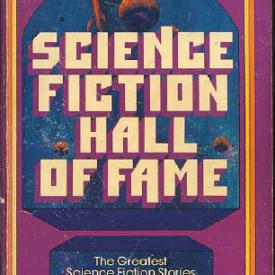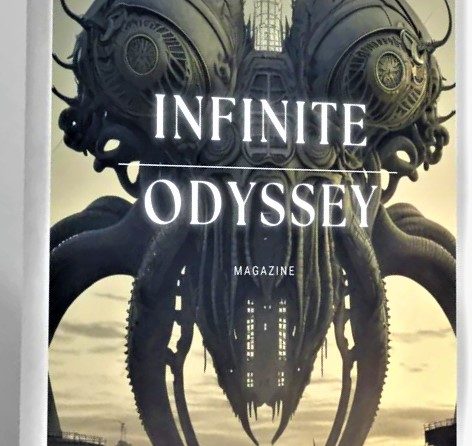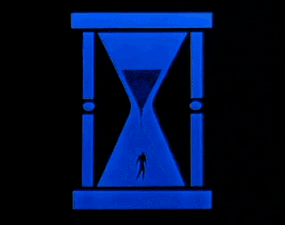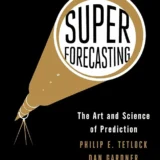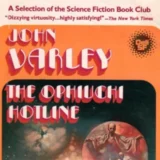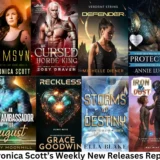 One would not imagine that a book like The Rolling Stones (originally published as Space Family Stone) would generate much controversy. One of the best-known of Heinlein’s juveniles, it is hard to imagine that there is anything that would cause offense within its pages. The main characters are interesting and realistic, while there is a distinct lack of sex, violence and war. One might even consider it bland. And yet, The Rolling Stones has been charged with everything from endorsing foolish and sexist behaviour to poor gender politics and outright misogyny.
One would not imagine that a book like The Rolling Stones (originally published as Space Family Stone) would generate much controversy. One of the best-known of Heinlein’s juveniles, it is hard to imagine that there is anything that would cause offense within its pages. The main characters are interesting and realistic, while there is a distinct lack of sex, violence and war. One might even consider it bland. And yet, The Rolling Stones has been charged with everything from endorsing foolish and sexist behaviour to poor gender politics and outright misogyny.
And, once again, the charges flounder on a simple lack of evidence.
The basic plot of The Rolling Stones is simple. Driven by wanderlust, and a simple awareness that life on the moon (!) is getting more and more bland every year, a family purchases a spacecraft and sets off on a tour of the solar system. They make their way to Mars (which is even more bureaucratic than Luna), then travel onwards to the asteroid belt, trading as they go. At the end of the story, which is surprisingly small-scale compared to some other books of that era, they resolve to go even further out …
Heinlein gambled, I suspect, by creating an ensemble cast for his book and, unsurprisingly, some characters get more screen time than others. The four main characters are the twins, Castor and Pollux; Roger Stone, their long-suffering and strait-laced father (although it is clear that he isn’t as strait-laced as he seems) and Hazel Stone, the grandmother. Beyond them, somewhat less developed, we have Edith Stone, Roger’s wife who also happens to be a doctor in her own right; Meade Stone, Roger and Edith’s oldest daughter and, at the bottom, Lovell/Buster Stone, the precocious toddler. There are no suggestions, here, that there is anything particularly unconventional about the family. The weird and wonderful family arrangements Heinlein would detail in his later books are absent here. Roger and his family could easily have stepped off a 1960s television screen.
The futuristic world Heinlein created for his story, too, isn’t that different from 1960s America. There may be spacecraft and aliens – the mysterious entities who live on Mars are very similar to their counterparts in Stranger in a Strange Land – but much of their world is instantly recognizable, for better or worse. On one hand, civilians can buy second-hand spaceships straight off a parking lot, in much the same way a regular family would buy a second-hand camper van. On the other hand, the gender politics haven’t been upgraded that much. Hazel Stone, an engineer, admits that she more or less gave up on engineering after watching less capable men be promoted above her. (She later advises Meade not to follow an engineering career, even though she’s good at it. It will only break her heart.) Roger is – or thinks he is – very much the patriarch of the family. He makes it clear, time and time again, that he is the one making the final decisions, at least until his children grow up.
(illustrations from the Boy’s Life publication of Tramp Spaceship, the original title)

It’s easy to dislike this aspect of Roger and, I believe, it is the point that many critics of this novel use to attack it. Roger is a dominant figure who, in many ways, keeps his children under control. His idea of education doesn’t include much (if any) of the soft sciences, (art, social studies, etc), although I am inclined to share this viewpoint. And yet, he also gives his children plenty of room to grow and develop. It’s evident that his children love and respect him, even though they may also see him as a grumpy old stick-in-the-mud. He sees his first duty as protecting his family, which leads to a crisis when a virus outbreak on a nearby freighter leads to a demand for Edith’s services. Roger is horrified at the thought of sending his wife into danger, knowing that she might die … and what self-respecting father of that era would feel otherwise? One may see this as a character flaw – and it’s notable that he makes no actual attempt to stop Edith from going, once she’s made up her mind – but I think that it speaks well of him. Roger Stone may be old-fashioned, but he is a far more effective father than the more modern Homer Simpson or Daddy Pig. I’d sooner have Roger than most modern-day television fathers. And his family is certainly not as dysfunctional as the later Hugh Farnham’s.
It’s possible, of course, that Roger came by his traits honestly, from his mother. Hazel is a fun character, the plain-spoken and blunt grandmother who provides a sense of light-hearted amusement as well as the heart and soul of the story. It’s a lot easier to like Hazel than Roger, although Hazel makes it clear that Roger is an adult and – therefore – no longer the little boy she birthed. She certainly doesn’t see him as a failure; at one point, she makes a bet with the twins that they can’t pull the wool over their father’s eyes and wins. Heinlein is careful to make us like Hazel before telling us that she was the victim of sexism, establishing her competence so we are disposed to side with her. (Notably, Heinlein never suggests that Hazel’s detractors were right.) That said, Hazel and the twins have a great deal in common, both a shared sense of mischief and – perhaps more dangerously – a willingness to cut corners. It wasn’t until I was rereading the book that I realised that Heinlein was foreshadowing the final crisis. One can also interpret the whole scene to suggest that Hazel was never as good an engineer as she claimed.
[In The Moon is a Harsh Mistress, a character appears who is supposed to be a younger version of Hazel. But as there are no other ties between that book and this, and it’s difficult to see how the society in one book could lead to the other, I’m inclined to take it as a reference rather than a direct link.]
The twins, Castor and Pollux, are technological geniuses – they’re responsible for inventing a piece of technology several years before the story’s start – but they are also strikingly immature and somewhat naive. Setting out on a trading junket is their idea, yet the way they go about it is rather unwise. (Their first plan involves smuggling alcohol to Mars; their second, when their father squashes that idea, nearly runs afoul of the law.) Their reach – and imagination – exceeds their grasp. Indeed, one may say that the story is really the story of the twins growing up. The scare they get at the end of the book, where their carelessness nearly gets their grandmother and younger brother killed, teaches them a lesson that was, in many ways, long overdue.
They’re fun and quite recognisable characters too, without the nasty edge that befouls Fred and George Weasley. I suspect they were meant to be the true stars of the book, the kind of young men that every teenage boy would want to be. They have moments of kindness – they purchase a pet for their younger brother – mingled with immaturity of a strikingly unsurprising kind. (They are horrified at the thought of having to travel with Meade, when their older sister points out that she could go with them as a responsible adult; girls may not be boring, but sisters generally are.)
The lesser characters suffer, it must be noted, because they are part of the scenery. And yet, even they have their moments.
 The mother, Edith, seems to be a quieter person than her mother-in-law. She’s a doctor – again, Heinlein was making a positive statement at a time when such statements were few and far between – but also a recognisable housewife. She doesn’t seek to crush or dominate her husband, but tries – instead – to bring him round to her way of thinking. And she’s brave, willing to uphold her medical oath and walk onto a plague ship. She may not be the Strong Female Action Heroine beloved of modern-day novels and films, but she is a strong character in her own way.
The mother, Edith, seems to be a quieter person than her mother-in-law. She’s a doctor – again, Heinlein was making a positive statement at a time when such statements were few and far between – but also a recognisable housewife. She doesn’t seek to crush or dominate her husband, but tries – instead – to bring him round to her way of thinking. And she’s brave, willing to uphold her medical oath and walk onto a plague ship. She may not be the Strong Female Action Heroine beloved of modern-day novels and films, but she is a strong character in her own way.
Meade is both a wasted opportunity and, in some ways, a developed character in her own right. Critics have accused Heinlein of sexism, for reasons both valid and absurd. Meade is not the focus of the story (Heinlein was writing for boys) and it is unfair to expect her to have a dedicated character arc of her own. And yet, she does have her moments. She mischievously reminds the twins, when they’re sulking about Roger refusing to let them set off on their own before they reach their majority, that she could go with them. It’s clear that she does have a life outside the home, including a certain number of romantic relationships that never seem to work out. And her sense of humour occasionally manifests at the oddest times.
Indeed, the question ‘but what about Meade?’ has been taken out of context and used to attack Heinlein. Apparently, being ‘husband-high’ is a bad thing. And yet, it’s quite clear, from reading the section, that Meade is faced with the choice of staying on the ship (where there are no eligible males) or leaving. And when she makes the choice to stay, everyone respects her choice. It may be the wrong choice, but it was hers. The only character in the book who can be deemed supercargo is Lovell, the baby. And even he has his moments.
The Rolling Stones, as I said above, isn’t a violent book. And yet, it does pose an endless series of problems for the characters, both minor and major. Individually, poor Roger must contend with his duties to his family and his own urge to head outwards; the twins must struggle with the call of adulthood – and adult responsibilities – even as they want to indulge their whims. And, on a greater scale, they face an ever-increasing series of challenges and dilemmas. Should they turn back, when Lowell starts showing signs of space-sickness, or risk his life by carrying on? Should Edith go to the plague ship when there is a very real risk of catching the disease and leaving her family without a mother? The book is clear that some problems cannot be overlooked, nor left to fester. Indeed, the most heart-stopping moment of the book comes directly after the twins make a simple, but deadly mistake.
At its core, The Rolling Stones is about growing up. And, as such, it is the twins who are perhaps the most important. The immature teenage brats we meet at the start have grown up by the end, learning a hard lesson that their father tried to impart to them when they were children. Roger’s quiet lecture, when he appears to be threatening to beat the twins – and then telling them that they’ll have to live with what they did – is perhaps the most emotional part of the book. Roger and Hazel, too, change and grow as the story reaches the end; Roger abandons his stodgy persona, while Hazel sets herself the challenge of seeing the rest of the solar system before her death. Nothing significant changes on a grand scale, not in this book, but the characters will never be the same again.
The book is also, by present-day standards, remarkably clean. Heinlein wryly hints that a spacesuit makes an excellent chaperone. Meade may go walking out with an officer from another ship, but there’s no hint that she – or anyone else – has been doing anything as shocking as (GASP) kissing. Roger may come across as a little cold because he showed very little warm affection to his wife, even though his readership was probably very familiar with husbands giving wives (GASP, GASP) pecks on the cheek.
 And yet, it also allows for a certain amount of social commentary and wry reflection, hints – perhaps – of the expanded universes Heinlein would later create. Apart from the sexism angle, the book touches on law and bureaucratic overreach – and how it can cast a baleful shadow over free enterprise. It studies the proper role of the father in the upbringing of teenage boys and girls – Roger is not an abusive father by any reasonable standard – and how, eventually, the children have to fly free. And, perhaps, questions where duty to one’s family overrides duty to others. And, perhaps most importantly, highlights the dangers of not taking every little precaution seriously, no matter how silly it seems.
And yet, it also allows for a certain amount of social commentary and wry reflection, hints – perhaps – of the expanded universes Heinlein would later create. Apart from the sexism angle, the book touches on law and bureaucratic overreach – and how it can cast a baleful shadow over free enterprise. It studies the proper role of the father in the upbringing of teenage boys and girls – Roger is not an abusive father by any reasonable standard – and how, eventually, the children have to fly free. And, perhaps, questions where duty to one’s family overrides duty to others. And, perhaps most importantly, highlights the dangers of not taking every little precaution seriously, no matter how silly it seems.
Heinlein’s technological predictions of the future were way off, in many ways. The Rolling Stones features a spacecraft that is amazingly simple, as easy to repair as a family car from the 1960s. There are no real computers, not in the sense that we would recognise them; ballistic trajectories are calculated by slide rules and checked and rechecked time and time again before the crew commit themselves. His social predictions were also way off, although he does point out – quite rightly – that social attitudes change slower than laws. The companies that refused to hire or promote Hazel were, in the book, breaking the law. And his solar system is a curious mix of the real and the fantastic. Mars is a life-bearing world, home to enigmatic aliens and the flat-cats (who may have inspired a far more famous science-fiction animal); the asteroid belt is the wild west, with prospectors searching for rare ores instead of gold.
But none of that matters, because The Rolling Stones is good clean fun.
I’ve written before about the secret of storytelling for all ages. The Rolling Stones qualifies, quite nicely, as a book that appeals to the young as well as the old. Children and teens might admire the twins, adore the grandmother and respect the father. Adults might admire the sheer skill in which Heinlein crafts his world, making you see aspects that a child might overlook. There are no wars in The Rolling Stones; no space pirates, no human hazards … but that doesn’t stop it being exciting. And there is a charm about it that cannot be denied.
Overall, The Rolling Stones is one of Heinlein’s best books. And it doesn’t deserve to be slandered by people who are unable or unwilling to understand the limitations facing Heinlein at the time he wrote.









